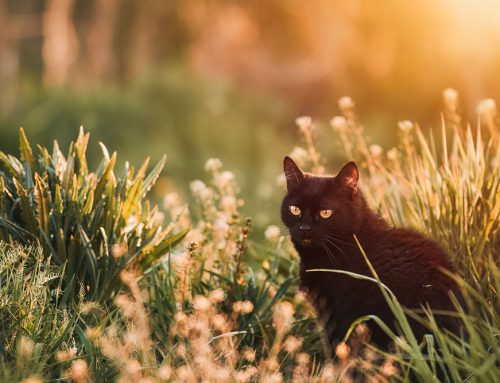Even though the dog days of summer may be upon us, our feline friends also need special summertime care to prevent heat exhaustion.
Kitties tend to be a little more sensible than dogs when it comes to summertime safety. (Ever see an exuberant Lab know when to quit on a scorching day?) Games of fetch, hiking sessions, and running errands in the car are not activities our finicky felines tend to enjoy. Cats are much better than their canine counterparts at seeking out comfort and staying cool in the summer. But, that doesn’t mean they’re immune to the dangers of excessive heat.
Cats do not tolerate the heat well. They are unable to sweat, other than through their paw pads, so eliminating excess body heat is difficult, and they can quickly overheat in scorching summer conditions. To prevent heatstroke from occurring in your cat, follow these tips:
- Provide adequate water. Cats don’t do the best job of hydrating themselves, so make water more appealing by using a fountain or adding a small amount of low-sodium chicken broth to the water dish.
- Supply plenty of shade. Cats may enjoy lounging on a sunny windowsill, but spending the day outdoors in direct sunlight can be deadly. If your cat goes outside, be sure she has access to shady areas.
- Provide appropriate ventilation. Verify that there is enough ventilation in the area where your cat likes to hang out. Never allow your feline friend to become trapped in a shed or garage with inadequate ventilation. These buildings can quickly become stifling in the heat.
- Keep a close eye on high-risk cats. Some cats are at higher risk of overheating than others. Pay extra attention to your cat if she:
- Is a brachycephalic (or flat-faced) breed — Persians, Himalayans, and similar breeds already have difficulty breathing without adding high heat and humidity into the mix.
- Has a heart or respiratory condition — Cats can have several different heart conditions that can make it difficult to adequately breathe, circulate blood, and perfuse their blood with oxygen. In addition, asthma or polyps (small masses) in the nose or throat can compound breathing difficulties.
- Is overweight or obese — That thicker layer of fat can make it more difficult for your cat to shed excess body heat.
- Have your cat properly groomed. An animal’s fur coat helps to regulate her body temperature. If the fur becomes matted or is shaved down to the skin, your cat will lose her protection from the elements. A well-groomed coat will provide protection from the sun and help circulate cool air close to the skin.
Signs of heatstroke in cats
Sometimes, heatstroke can occur despite your best efforts to keep your cat safe. Watch for these signs of impending heatstroke:
- Rapid pulse or breathing
- Excessive panting (cats rarely pant)
- Sweaty feet
- Agitation
- Drooling
- Vomiting
- Diarrhea
- Bright red gums
- Weakness
- Seizures
- Collapse
Heatstroke is a medical emergency. If you notice any of these signs in your cat on a hot summer day, she must receive immediate medical attention. Follow these steps:
- If possible, take your cat’s rectal temperature. A normal temperature can be as high as 103 degrees in cats, especially when experiencing stress. If your cat’s temperature is hovering around 104, action must be taken to prevent further overheating.
- Move your cat to a well-ventilated and cool space.
- If your cat is still conscious, cool her off by wrapping her body in a cool (not cold) wet towel. Or, if she will tolerate it, you can lightly spray her with cool water, making sure to keep it out of her nose and mouth.
- When your cat is damp with cool water, attempt to place a fan in front of her to help heat evaporate.
- Provide plenty of cool water to drink, making it more appealing by adding tuna juice or low-sodium chicken broth.
- Once your cat’s temperature has reached 103 degrees, stop additional cooling actions.
- Call our office to inform us that you will be bringing your overheated cat in to allow for prompt treatment.
- Before transporting her to the animal hospital, be sure that your car is cooled down sufficiently. Only place her inside the vehicle once the air conditioning has made a difference in the temperature.
Even after stabilizing your cat’s temperature, she may not be completely out of the woods. Organ damage, neurological issues, or gastrointestinal upset can occur up to a week after a heatstroke, so keep a close eye on your cat while she recovers.
Questions about keeping your cat safe this summer? Call us at 615-444-4422.








Leave A Comment